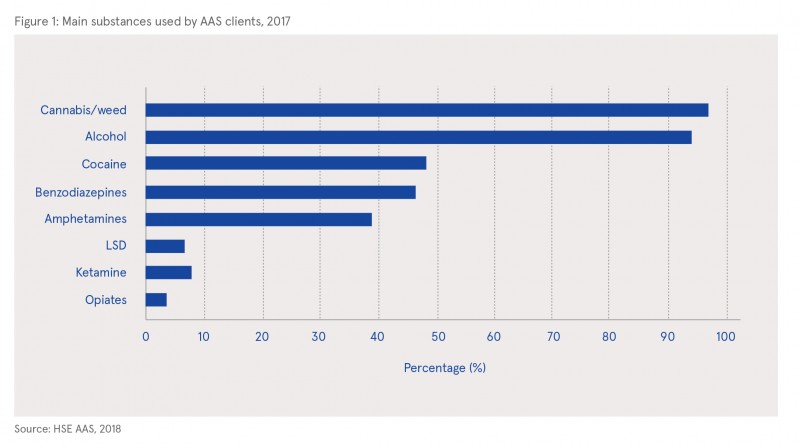Millar, Sean (2019) Adolescent addiction service report, 2018. Drugnet Ireland, Issue 70, Summer 2019, 28 p..
| Preview | Title | Contact |
|---|---|---|
|
PDF (Drugnet Ireland 70)
1MB |
The Health Service Executive (HSE) Adolescent Addiction Service (AAS) provides support and treatment in relation to alcohol and drug use for young people and families from the Dublin suburbs of Ballyfermot, Clondalkin, Palmerstown, Lucan, and Inchicore. Services provided include advice, assessment, counselling, family therapy, professional consultations, and medications if required. In 2018, the AAS published a report detailing referrals for 2017.1
Referrals
In 2017, the AAS worked with 44 young people and their families, with a mean age of 15.5 years (range: 14–18 years). This figure includes new referrals, re-referrals and continuances. The majority (84%) were male and 9% were non-Irish nationals. In terms of referral areas, the greatest numbers of referrals were from Clondalkin (48%) followed by Lucan (23%), Ballyfermot (20%), Inchicore (7%), and Palmerstown (2%).
Drug and alcohol use
Cannabis/weed continued to be the main substance used by clients at 97%, while alcohol use was at 95% (see Figure 1). Other substances of use included cocaine (48%), benzodiazepines (46%), amphetamines (39%), LSD (7%), ketamine (7%) and opiates (4%) (including heroin and Solpadeine). Solvents and head-shop-type products did not feature among young people’s substance use in 2017. The report noted that the biggest change concerning secondary drug use related to an increase in alcohol use by 35%, cocaine use by 19%, benzodiazepines by 13%, and amphetamines by 8%.

Other issues
Other issues presented related to indebtedness (30%) and absconding (40%), resulting in two young people accessing out-of-hours services. Additionally, seven young people had social work involvement and four had residential care placements. Hospital admission was high at 14% and 14% of people had a history of self-harm. Of those who exited treatment, 58% had a planned discharge, 27% declined further treatment, while 15% moved out of the community or returned to their community of origin. Of those who had planned discharges, less than 5% had onward referral to residential treatment or long-term residential aftercare. The majority of young people (82%) were seen by a family therapist only, with 18% having a psychiatric assessment.
Conclusions
The AAS report authors noted that, as in previous years, most young people had established patterns of substance use prior to referral (range: 1 month–4 years) and, as a consequence, some struggle to maintain a drug-free status. Nevertheless, most achieve stability and several remain abstinent. They concluded that there is a need for parents and non-parental adults to identify young people within risk groups at an early stage and to elevate concern for them.
1 Adolescent Addiction Service (2018) Adolescent Addiction Service report 2018. Dublin: Health Service Executive. https://www.drugsandalcohol.ie/29358/
Repository Staff Only: item control page